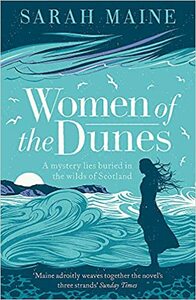Take a photo of a barcode or cover
adventurous
emotional
mysterious
medium-paced
Plot or Character Driven:
Character
Strong character development:
Yes
Loveable characters:
Yes
Diverse cast of characters:
Yes
Flaws of characters a main focus:
No
I really enjoyed the story. The multiple interwoven storylines made it an intriguing read. Along the line you got to know more about the three different times and how everything was connected. Somethings were predictable, but even so I thought it was a well-written story. As a former archaeologist I also enjoyed that the archeological parts were accurate and not the idealized version of what archaeology usually is in most books
adventurous
inspiring
mysterious
sad
medium-paced
Plot or Character Driven:
Plot
Strong character development:
Yes
Loveable characters:
Yes
Diverse cast of characters:
No
Flaws of characters a main focus:
Complicated
dark
mysterious
slow-paced
Plot or Character Driven:
A mix
Strong character development:
Complicated
Loveable characters:
No
Diverse cast of characters:
No
Flaws of characters a main focus:
No
Sarah Maine's first book involved two time periods; this book, her third, involves three: an early Christian/Viking situation, the late 1800s with atheist/Christian/economic class issues, and a modern day archaelogy/economic class/inheritance/clear-up-the earlier-mysteries setting. All three involve romance or perhaps not, senses of forces beyond individual control, and a question about the truth of legends. By involving three time periods, Maine has the opportunity to answer and demonstrate how legends are cobbled together.
Engaging, mostly complex, characters particularly in the modern setting. Clear delineations of time for the reader, though the story lines weave in and out of all three. Lovely descriptions of the western Scottish isles. (Since I am in the midst of watching all six seasons of the Australian drama "A Place to Call Home" the parallels of some characters [archetypes, if you will] was present.) Off to reserve Maine's second novel -- though the places remain similar, these are stand-alone novels.
Engaging, mostly complex, characters particularly in the modern setting. Clear delineations of time for the reader, though the story lines weave in and out of all three. Lovely descriptions of the western Scottish isles. (Since I am in the midst of watching all six seasons of the Australian drama "A Place to Call Home" the parallels of some characters [archetypes, if you will] was present.) Off to reserve Maine's second novel -- though the places remain similar, these are stand-alone novels.
mysterious
fast-paced
Plot or Character Driven:
Plot
Strong character development:
No
Loveable characters:
Yes
Diverse cast of characters:
No
Flaws of characters a main focus:
No
A Viking legend. A family story. And the excavation of an ancient mound amid the family drama of a storied mansion. These three timelines are woven together to form the plot of Sarah Maine’s Women of the Dunes.
Libby Snow is an archaeologist with a particular family interest in the legend of Ulla, a woman running from one brother and in love with another over 1000 years ago. Libby gets permission to excavate Viking ruins on Sturrock land in Ullaness off the coast of Scotland. Stern but attractive Rodri Sturrock manages the estate for his absent brother Hector. Libby keeps secret her family’s connection to Ullaness – her grandmother’s grandmother had moved to North America from this part of Scotland, carrying an ancient cross with her.
The story weaves together tales of star-crossed lovers. Excavation reveals the bones from more than one body, from more than one time period. The setting on the coast of Scotland is breathtaking. The plot takes some predictable turns, foreshadowed by the legend of the past, but surprised me at times as well. And I was happy when one villainous character proved not to be “foaming at the mouth stark raving mad,” as happens so often (too often) in mysteries, but a narcissist who acts entirely true to their spiteful nature.
Women of the Dunes is even better than Maine’s first book, The House Between Tides. The characters are well developed, and humor is done with a light touch. My favorite scene happens in Chapter 13, when Libby’s pretentious boss comes to visit the manor house and Rodri and his housekeeper Alice put on a lordly homeowner/simpering servant act for him.
Women of the Dunes is a definite recommend from me for anyone who enjoys a historical mystery/romance and the wilds of Scotland.
Libby Snow is an archaeologist with a particular family interest in the legend of Ulla, a woman running from one brother and in love with another over 1000 years ago. Libby gets permission to excavate Viking ruins on Sturrock land in Ullaness off the coast of Scotland. Stern but attractive Rodri Sturrock manages the estate for his absent brother Hector. Libby keeps secret her family’s connection to Ullaness – her grandmother’s grandmother had moved to North America from this part of Scotland, carrying an ancient cross with her.
The story weaves together tales of star-crossed lovers. Excavation reveals the bones from more than one body, from more than one time period. The setting on the coast of Scotland is breathtaking. The plot takes some predictable turns, foreshadowed by the legend of the past, but surprised me at times as well. And I was happy when one villainous character proved not to be “foaming at the mouth stark raving mad,” as happens so often (too often) in mysteries, but a narcissist who acts entirely true to their spiteful nature.
Women of the Dunes is even better than Maine’s first book, The House Between Tides. The characters are well developed, and humor is done with a light touch. My favorite scene happens in Chapter 13, when Libby’s pretentious boss comes to visit the manor house and Rodri and his housekeeper Alice put on a lordly homeowner/simpering servant act for him.
Women of the Dunes is a definite recommend from me for anyone who enjoys a historical mystery/romance and the wilds of Scotland.
I saw this book through to the end because I was reading it for a book club meeting - in the end, it was cancelled (the book club, not the book).
The book is told in three different timelines (one ancient, one Victorian, one modern day) and attempts to show the thread of history linked to one wild, emotive setting on the west coast of Scotland: Ullaness. The legend of Ulla and her ness (headland) springs from events in the time of Viking raids in Scotland and Ireland and is passed down, more or less faithfully through the generations. It survives the embellishments of the Victorian era and echoes through to the present day.
Throughout time, elements of the legend are repeated - relived. There is a recurring theme of warring brothers, wronged women, children fathered by an absent parent and various complex love interests.
In summary: the setting is evocative - there are some good points made about legends - I'm sure the archaeological detail is accurate - and yet the book didn't touch me - it left me cold.
Maybe there's just not enough of the Romantic in me?
(Now where's my copy of 'It'?)
The book is told in three different timelines (one ancient, one Victorian, one modern day) and attempts to show the thread of history linked to one wild, emotive setting on the west coast of Scotland: Ullaness. The legend of Ulla and her ness (headland) springs from events in the time of Viking raids in Scotland and Ireland and is passed down, more or less faithfully through the generations. It survives the embellishments of the Victorian era and echoes through to the present day.
Throughout time, elements of the legend are repeated - relived. There is a recurring theme of warring brothers, wronged women, children fathered by an absent parent and various complex love interests.
In summary: the setting is evocative - there are some good points made about legends - I'm sure the archaeological detail is accurate - and yet the book didn't touch me - it left me cold.
Maybe there's just not enough of the Romantic in me?
(Now where's my copy of 'It'?)
Mostly interesting story, though it was a bit long, in my opinion, and I did get annoyed with Libby for not asking questions sooner, ha ha.
Loved the coastal Scotland location, of course!
Loved the coastal Scotland location, of course!
Well, I was quite curious about this one. Love the name and the cover.
It's a bit slowed pace for me,but I enjoyed reading it.
It's narrated through 3 different times. But I didn't really understand why sometimes in same chapter it showed to times. I didn't fell right, I read 2 similar books in terms of construction this year and I kind of compared them unconsciously I suppose.
It's a mystery.
You don't understand if there's a slow burn romance going on or just some complicity happening. It's strange.
Sure, it is a historical novel, with what seems to be a repeating pattern.
To me it was okay, although it has potential.
It's a bit slowed pace for me,but I enjoyed reading it.
It's narrated through 3 different times. But I didn't really understand why sometimes in same chapter it showed to times. I didn't fell right, I read 2 similar books in terms of construction this year and I kind of compared them unconsciously I suppose.
It's a mystery.
You don't understand if there's a slow burn romance going on or just some complicity happening. It's strange.
Sure, it is a historical novel, with what seems to be a repeating pattern.
To me it was okay, although it has potential.
adventurous
challenging
dark
mysterious
tense
medium-paced





